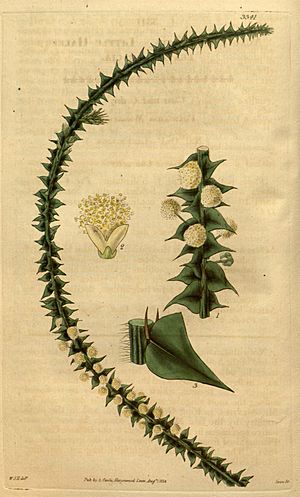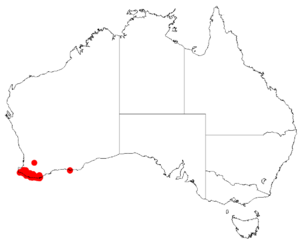Acacia hastulata facts for kids
Quick facts for kids Acacia hastulata |
|
|---|---|
 |
|
| Illustration of Acacia hastulata | |
| Scientific classification | |
| Genus: |
Acacia
|
| Species: |
hastulata
|
 |
|
| Occurrence data from AVH | |
Acacia hastulata is a type of shrub that belongs to the Acacia family, also known as wattles. This special plant grows only in the southwestern part of Australia. It's a unique shrub that adds to Australia's amazing plant life.
Contents
What Does Acacia hastulata Look Like?
This slender, spreading shrub usually grows to be about 0.3 to 2.0 meters (1 to 6.5 feet) tall. It often has a tangled, intricate shape. Its branches are long and thin, colored red to orange-brown. They can be straight or curve downwards. These branches have small, soft hairs and tiny, narrow leaf-like parts called stipules, which are about 2.5 to 4 millimeters long.
Like many wattles, Acacia hastulata doesn't have true leaves. Instead, it has special flattened stems called phyllodes. These phyllodes are crowded together and stick out. They are shaped like a narrow spearhead, tapering to a sharp point. They are tough and have a clear central line. These pointy phyllodes are about 3.5 to 6 millimeters long and 2 to 3 millimeters wide. They are also smooth, meaning they don't have hairs.
Flowers and Seed Pods
From July to November, this shrub produces pretty cream-yellow flowers. The flowers grow in small, round clusters, usually one cluster per leaf axil (the spot where a leaf meets the stem). These flower clusters are on smooth stalks about 2 to 4 millimeters long. Each round flower-head has three to five creamy yellow flowers.
After the flowers bloom, red-brown, striped seed pods form. These pods are curved and round, narrowing at both ends. They can grow up to 5.5 centimeters (2.2 inches) long and are about 1.5 to 2 millimeters wide. Inside the pods, the seeds are oblong or slightly oval-shaped, about 2.5 to 3.5 millimeters long. Each seed has a small, fleshy attachment called an aril at one end.
How Was Acacia hastulata Named?
This plant was first officially described by a botanist named James Edward Smith in 1818. A botanist is a scientist who studies plants. He included the description in a large book called The Cyclopaedia.
Later, in 2003, another botanist named Leslie Pedley reclassified it, giving it a new name: Racosperma hastulatum. However, in 2014, it was moved back to the Acacia group.
Acacia hastulata is part of a group of wattles called the Acacia horridula group. But it's easy to tell it apart from others in this group because of the unique spearhead shape of its phyllodes. The first sample of this plant, called the type specimen, was collected near King George Sound by Archibald Menzies during the Vancouver Expedition.
Where Does Acacia hastulata Grow?
This plant is native to the southern coast of Western Australia. You can find it in the Goldfields-Esperance, Great Southern, and South West regions. It commonly grows near water, like along watercourses and in swampy areas.
Most of these plants are found from south of Nannup and the Scott River in the west, all the way to Albany in the east. There's also a separate group of them much further east, near Esperance. In these areas, Acacia hastulata grows in forests, often alongside other plant species like Melaleuca or Banksia, and sometimes in Karri forest communities.

